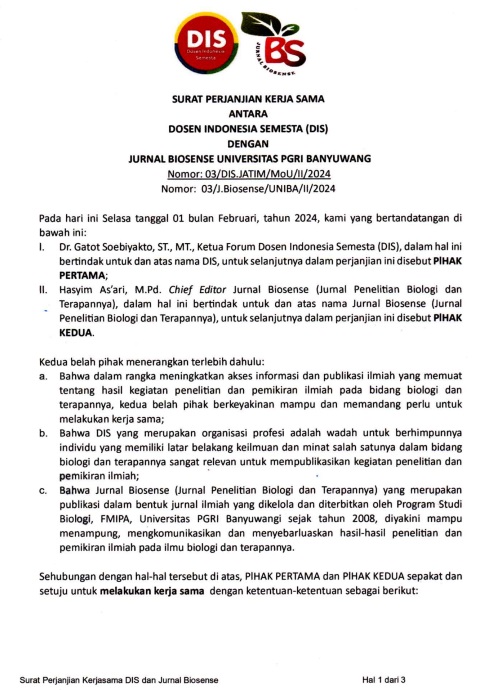EKSPLORASI SUBSTRAT SINGLE-CHAMBER AIR-CATHODE MICROBIAL FUEL CELL DENGAN ELEKTRODA STAINLESS STEEL DAN KARBON AKTIF
DOI:
https://doi.org/10.36526/biosense.v5i01.2006Keywords:
Energi terbarukan, listrik, microbial fuel cell, substratAbstract
Pengembangan energi substitusi terbarukan dan ramah lingkungan harus dilakukan untuk menggantikan peran energi fosil. Salah satu teknologi untuk menghasilkan energi ini adalah microbial fuel cells (MFCs). Teknologi ini memanfaatkan mikroorganisme untuk menghasilkan listrik secara langsung melalui perombakan molekul organik dalam proses respirasi seluler. Penelitian ini merupakan penelitian awal yang bertujuan untuk mengeksplorasi substrat dan mikroorganisme yang berpotensi untuk digunakan dalam teknologi MFCs. Tipe reaktor MFCs yang digunakan adalah membraneless, single chamber air-cathode. Substrat yang diinokulasi ke dalam reaktor diambil dari tiga sumber yang berbeda, yaitu endapan lumpur bakau, tanah berlumpur dari kebun dan endapan saluran pembuangan rumah tangga. Material elektroda yang digunakan adalah kombinasi stainless steel mesh dan karbon aktif. MFCs dioperasikan selama 3 siklus (1 siklus = 7 hari), dan di akhir siklus, reaktor MFCs dibersihkan dan diganti dengan substrat yang baru. Hasil pengoperasian MFCs selama 3 siklus menunjukkan bahwa substrat dari endapan lumpur bakau menghasilkan tegangan listrik sebesar 101,54 mV. Sedangkan, substrat tanah berlumpur dan endapan saluran pembuangan rumah tangga menghasikan tegangan sebesar 15,8 mV dan 13,06 mV. Dengan penelitian yang lebih mendalam, substrat endapan lumpur bakau berpotensi untuk digunakan dalam teknologi MFCs. Penelitian ini diharapkan dapat memperkenalkan teknologi MFCs kepada masyarakat, agar dapat dikembangkan untuk mengelola limbah dan menghasilkan energi terbarukan.
References
Arifin, Z. (2015). Konsumsi Bbm Untuk Pembangkit Listrik Di Indonesia; Kecenderungan, Permasalahan Dan Solusinya. M & E, 13(2), 85–95.
Chairani, S. (2014). Anaerobik Co-digesi Limbah Tanaman Jagung (Zea mays) dan Digested Manure Sapi Terhadap Peningkatan Produksi Biogas Sebagai Energi Terbarukan dengan Menggunakan Reaktor Mesophilic. Prosiding Seminar Nasional PERTETA dan HIPI, 10.
De La Fuente, M., Daille, L., De la Iglesia, R., Walczak, M., Armijo, J., Pizarro, G., & Vargas, I. (2020). Electrochemical Bacterial Enrichment from Natural Seawater and Its Implications in Biocorrosion of Stainless-Steel Electrodes. Materials, 13, 2327. https://doi.org/10.3390/ma13102327
Deval, A., & Dikshit, A. K. (2013). Construction, Working and Standardization of Microbial Fuel Cell. APCBEE Procedia, 5, 59–63. https://doi.org/10.1016/j.apcbee.2013.05.011
Dumas, C., Mollica, A., Féron, D., Basseguy, R., Etcheverry, L., & Bergel, A. (2007). Marine Microbial Fuel Cell: Use of Stainless Steel Electrodes as Anode and Cathode Materials. Electrochimica Acta, 53. https://doi.org/10.1016/j.electacta.2007.06.069
González-Gamboa, N., Tapia-Tussell, R., Kamaraj, S. K., Valdés-Lozano, D., Domínguez-Maldonado, J., & Alzate-Gaviria, L. (2021). Scale Up of a Marine Sediment Microbial Fuel Cells Stack with a Floating Aerated Cathode Using a Circuit Storage Energy from Ultra-Low Power. Waste and Biomass Valorization, 12(7), 3977–3985. https://doi.org/10.1007/s12649-020-01289-7
Guerrini, E., Cristiani, P., Grattieri, M., Santoro, C., Li, B., & Trasatti, S. (2014). Electrochemical Behavior of Stainless Steel Anodes in Membraneless Microbial Fuel Cells. Journal of The Electrochemical Society, 161, H62–H67. https://doi.org/10.1149/2.096401jes
Heidrich, E. S., Dolfing, J., Wade, M. J., Sloan, W. T., Quince, C., & Curtis, T. P. (2018). Temperature, Inocula and Substrate: Contrasting Electroactive Consortia, Diversity and Performance in Microbial Fuel Cells. Bioelectrochemistry, 119, 43–50. https://doi.org/10.1016/j.bioelechem.2017.07.006
Hodgson, D. M., Smith, A., Dahale, S., Stratford, J. P., Li, J. V., Grüning, A., Bushell, M. E., Marchesi, J. R., & Avignone Rossa, C. (2016). Segregation of the Anodic Microbial Communities in a Microbial Fuel Cell Cascade. Frontiers in Microbiology, 7. https://doi.org/10.3389/fmicb.2016.00699
Huarachi-Olivera, R., Dueñas-Gonza, A., Yapo-Pari, U., Vega, P., Romero-Ugarte, M., Tapia, J., Molina, L., Lazarte-Rivera, A., Pacheco-Salazar, D. G., & Esparza, M. (2018). Bioelectrogenesis with Microbial Fuel Cells (mfcs) Using the Microalga Chlorella Vulgaris and Bacterial Communities. Electronic Journal of Biotechnology, 31, 34–43. https://doi.org/10.1016/j.ejbt.2017.10.013
Ihsan, A., Bahri, S., & Musafira, M. (2013). Produksi Biogas Menggunakan Cairan Isi Rumen Sapi dengan Limbah Cair Tempe. Natural Science: Journal of Science and Technology, 2(2), Article 2. https://doi.org/10.22487/25411969.2013.v2.i2.1644
Indonesia.go.id. (2020). Tabung Listrik Mungil untuk Daerah Terpencil. Indonesia.Go.Id. https://www.indonesia.go.id/narasi/indonesia-dalam-angka/ekonomi/tabung-listrik-mungil-untuk-daerah-terpencil
Januarita, R., & Azizah, A. (2015). MFCs 2 in 1: Microbial Fuel Cells Pengolah Air Limbah Dan Penghasil Listrik (alternatif: Limbah Isi Rumen Sapi Dengan Pengaruh Variasi Cod Dan Ph). Artikel Ilmiah - Universitas Diponegoro, 6. http://ejournal-s1.undip.ac.id/index.php
Kiely, P., Call, D., Yates, M., Regan, J., & Logan, B. (2010). Anodic Biofilms in Microbial Fuel Cells Harbor Low Numbers of Higher-Power-Producing Bacteria Than Abundant Genera. Applied Microbiology and Biotechnology, 88, 371–380. https://doi.org/10.1007/s00253-010-2757-2
Logan, B. E., Hamelers, B., Rozendal, R., Schröder, U., Keller, J., Freguia, S., Aelterman, P., Verstraete, W., & Rabaey, K. (2006). Microbial Fuel Cells: Methodology and Technology †. Environmental Science & Technology, 40(17), 5181–5192. https://doi.org/10.1021/es0605016
Logan, B. E., & Regan, J. M. (2006). Electricity-Producing Bacterial Communities in Microbial Fuel Cells. Trends in Microbiology, 14(12), 512–518. https://doi.org/10.1016/j.tim.2006.10.003
Mago, O. Y. T., Nirmalasari, M. A. Y., Kuki, A. D., Bunga, Y. N., & Misa, A. (2021). Effect of the Type of Organic Waste and Retention Time on Biogas Production from Cow Dung. Biota : Jurnal Ilmiah Ilmu-Ilmu Hayati, 5(3), 155–162. https://doi.org/10.24002/biota.v5i3.3682
Masoudi, M., Rahimnejad, M., & Mashkour, M. (2020). Fabrication of Anode Electrode by a Novel Acrylic Based Graphite Paint on Stainless Steel Mesh and Investigating Biofilm Effect on Electrochemical Behavior of Anode in a Single Chamber Microbial Fuel Cell. Electrochimica Acta, 344, 136168. https://doi.org/10.1016/j.electacta.2020.136168
Morales-Polo, C., Cledera-Castro, M. del M., & Soria, B. Y. M. (2019). Biogas Production from Vegetable and Fruit Markets Waste—Compositional and Batch Characterizations. Sustainability, 11(23), 6790. https://doi.org/10.3390/su11236790
Nam, T., Son, S., Kim, E., Tran, H. V. H., Koo, B., Chai, H., Kim, J., Pandit, S., Gurung, A., Oh, S.-E., Kim, E. J., Choi, Y., & Jung, S. P. (2018). Improved Structures of Stainless Steel Current Collector Increase Power Generation of Microbial Fuel Cells by Decreasing Cathodic Charge Transfer Impedance. Environmental Engineering Research, 23(4), 383–389. https://doi.org/10.4491/eer.2017.171
Nealson, K. H., & Rowe, A. R. (2016). Electromicrobiology: Realities, Grand Challenges, Goals and Predictions. Microbial Biotechnology, 9(5), 595–600. https://doi.org/10.1111/1751-7915.12400
Pant, D., Bogaert, G., Diels, L., & Vanbroekhoven, K. (2009). A Review of the Substrates Used in Microbial Fuel Cells (mfcs) for Sustainable Energy Production. Bioresource Technology, 101, 1533–1543. https://doi.org/10.1016/j.biortech.2009.10.017
Peng, X. H., Chu, X. Z., Huang, P. F., & Shan, K. (2015). Improved Power Performance of Activated Carbon Anode by Fe2O3 Addition in Microbial Fuel Cells. Applied Mechanics and Materials, 700, 170–174. https://doi.org/10.4028/www.scientific.net/AMM.700.170
Pinto, D. (2016). Electronic Transfer Within a Microbial Fuel Cell. Better Understanding of Experimental and Structural Parameters at the Interface Between Electro-Active Bacteria and Carbon-Based Electrodes [Doctoral thesis of Material Chemistry]. Université Pierre et Marie Curie.
Prayogo, F. A., Suprihadi, A., & Raharjo, B. (2017). Microbial Fuel Cell (MFC) Menggunakan Bakteri Bacillus Subtilis dengan Substrat Limbah Septic Tank Serta Pengaruhnya Terhadap Kualitas Limbah. Jurnal Biologi, 6(2), 10.
Putri, S. K., & Sudiyo, R. (2012). Studi Proses Pembuatan Biodiesel dari Minyak Kelapa (Coconut Oil) dengan Bantuan Gelombang Ultrasonik. Jurnal Rekayasa Proses, 6(1), 6.
Rahimnejad, M., Adhami, A., Darvari, S., Zirepour, A., & Oh, S.-E. (2015). Microbial Fuel Cell as New Technology for Bioelectricity Generation: A Review. Alexandria Engineering Journal, 54(3), 745–756. https://doi.org/10.1016/j.aej.2015.03.031
Ridhuan, K. (2016). Pengolahan Limbah Cair Tahu Sebagai Energi Alternatif Biogas yang ramah lingkungan. Turbo : Jurnal Program Studi Teknik Mesin, 1(1). https://doi.org/10.24127/trb.v1i1.81
Ritonga, A. M., & Masrukhi, M. (2017). Optimasi Kandungan Metana (CH4) Biogas Kotoran Sapi Menggunakan Berbagai Jenis Adsorben. Jurnal Rona Teknik Pertanian, 10(2). https://doi.org/10.17969/rtp.v10i2.8493
Samudro, G., Syafrudin, S., Nugraha, W. D., Priyambada, I. B., Muthi’ah, H., Sinaga, G. N., & Hakiem, R. T. (2017). Kajian Pemilihan Sumber Mikroorganisme Solid Phase Microbial Fuel Cell (SMFC) Berdasarkan Jenis dan Volume Sampah, Power Density dan Efisiensi Penurunan COD. Jurnal Sains & Teknologi Lingkungan, 9(2), 114–121. https://doi.org/10.20885/jstl.vol9.iss2.art5
Santoro, C., Flores-Cadengo, C., Soavi, F., Kodali, M., Merino-Jimenez, I., Gajda, I., Greenman, J., Ieropoulos, I., & Atanassov, P. (2018). Ceramic Microbial Fuel Cells Stack: Power Generation in Standard and Supercapacitive Mode. Scientific Reports, 8(1), 3281. https://doi.org/10.1038/s41598-018-21404-y
Schröder, U. (2007). Anodic Electron Transfer Mechanisms in Microbial Fuel Cells and Their Energy Efficiency. Phys. Chem. Chem. Phys., 9(21), 2619–2629. https://doi.org/10.1039/B703627M
Scott, K., Cotlarciuc, I., Hall, D., Lakeman, J., & Browning, D. (2008). Power from Marine Sediment Fuel Cells: The Influence of Anode Material. Journal of Applied Electrochemistry, 38, 1313–1319. https://doi.org/10.1007/s10800-008-9561-z
Sekretariat Jenderal Dewan Energi Nasional. (2019). Outlook Energi Indonesia 2019. https://www.esdm.go.id/assets/media/content/content-outlook-energi-indonesia-2019-bahasa-indonesia.pdf
Songera, D. (2012). A Review on Microbial Fuel Cell Using Organic Waste as Feed. CIBTech Journal of Biotechnology, Vol. 2, 17–22.
Sudirjo, E., Buisman, C. J. N., & Strik, D. P. B. T. B. (2019). Marine Sediment Mixed With Activated Carbon Allows Electricity Production and Storage From Internal and External Energy Sources: A New Rechargeable Bio-Battery With Bi-Directional Electron Transfer Properties. Frontiers in Microbiology, 10, 934. https://doi.org/10.3389/fmicb.2019.00934
Tharali, A. D., Sain, N., & Osborne, W. J. (2016). Microbial Fuel Cells in Bioelectricity Production. Frontiers in Life Science, 9(4), 252–266. https://doi.org/10.1080/21553769.2016.1230787
Wenten, I. G. (2010). Review Proses Produksi Biodiesel Dengan Menggunakan Membran Reaktor. Seminar Rekayasa Kimia Dan Proses 2010, 9.
Yamashita, T., Ishida, M., Asakawa, S., Kanamori, H., Sasaki, H., Ogino, A., Katayose, Y., Hatta, T., & Yokoyama, H. (2016). Enhanced Electrical Power Generation Using Flame-Oxidized Stainless Steel Anode in Microbial Fuel Cells and the Anodic Community Structure. Biotechnology for Biofuels, 9(1), 1–10. https://doi.org/10.1186/s13068-016-0480-7
Yates, M. D., Kiely, P. D., Call, D. F., Rismani-Yazdi, H., Bibby, K., Peccia, J., Regan, J. M., & Logan, B. E. (2012). Convergent Development of Anodic Bacterial Communities in Microbial Fuel Cells. The ISME Journal, 6(11), 2002–2013. https://doi.org/10.1038/ismej.2012.42
Zhao, F., Rahunen, N., Varcoe, J. R., Chandra, A., Avignone-Rossa, C., Thumser, A. E., & Slade, R. C. T. (2008). Activated Carbon Cloth as Anode for Sulfate Removal in a Microbial Fuel Cell. Environmental Science & Technology, 42(13), 4971–4976. https://doi.org/10.1021/es8003766

















